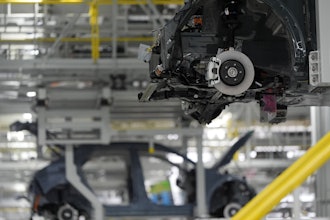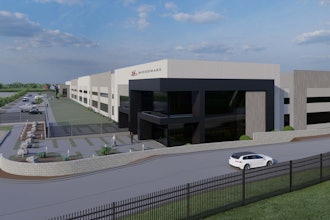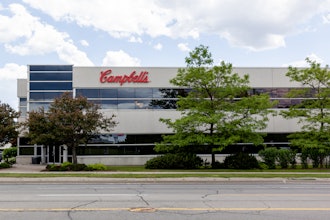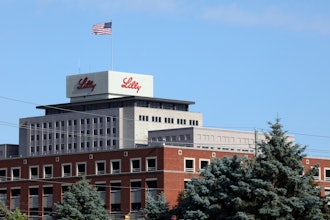It's not all glitz and glamour in the food industry. Behind every shiny bag of irresistibly crispy potato chips on the grocery shelf is water used to wash the potatoes, dirt and stones recovered from the wash process, peels from each and every potato and even, unfortunately, potatoes that didn't quite make the quality cut. What I'm talking about are byproducts - tons and tons of byproducts.
Byproducts present each individual plant with a decision. The food processing industry is in a unique position because, for the most part, plants can determine ahead of time the quantity and quality of their waste stream. Without the element of surprise, it is easier for them to find defined markets for their byproducts.
Decisions regarding byproducts are based on several factors - nutrient content of waste, palletability of waste, geographics, state and federal regulations, long standing local contracts and relationships and perhaps most importantly, cost.
There are a few well-known options for today's food processors, but the availability of emerging technologies and new market concerns may cause processors to reevaluate byproduct options.
Land Application
One commonly exercised option for food processing byproducts is land application. Put simply, a plant's biosolids are turned into a fertilizer supplement and spread on farmland to enrich the soil.
Obviously, in order to implement this approach, you will need land access. This involves a plant either establishing its own relationships with nearby farmers, or going through a third party professional to facilitate these contracts
What it takes
There are several steps involved in the land application process.
- Testing: Byproducts need to be tested in order to determine their suitability as an agricultural fertilizer supplement. Heavy metal (such as lead, copper, chromium) concentrations need to be determined.
- Permitting: Regulations vary by state. Most regulations are geared towards protecting state waters. At the end of the day, however, the burden of staying current on regulations inevitably falls on the plant engineers, as all the permits are in the plant's (the generator's) name, rather than the local farmer.
- Land Procurement: A plant must market its byproducts to local farmers, proving to them that the spreading will benefit crops. Farms should be as close to the plant as possible (ideally within a 10-15 mile radius) to keep trucking costs to a minimum.
- Trucking: In most cases, plants will be responsible for trucking byproducts safely to local farms so that they may be land spread.
- Record Keeping: A plant should maintain detailed reports of which byproducts were sent to what farms and how much product was provided.
Getting help
- Because many plant managers don't have the time to worry about byproducts beyond just getting them out the plant door, employing the expertise of a third party professional could help alleviate the burden of byproduct management. A recent survey of Food Manufacturing readers revealed that 33 percent feel a middle man would help their companies to become more active in byproduct recycling, while 13 percent are already using such resources.
- Another reason to seek help is that land application greatly loses its effectiveness when not done correctly. Ray DeLong, President and owner of a company called Environmental Land Management, stresses the importance of not overspreading byproducts. "When you overspread, nitrogen can leach down into the soil and affect the ground water," cautions DeLong. "In addition, each state regulates the distance between land applications and bodies of water. In the winter, we double the regulated distance to make sure material doesn't move with melting snow."
- With 15 years in the business, DeLong uses his experience to rid his customers of all burdens involved in disposing of byproducts. His company will handle regulations, byproduct testing, permitting and marketing to area farmers, which includes demonstrating to them that the free land application will benefit crops. He will also coordinate deliveries with each field's harvest schedules and truck the byproducts from plants, spread them and periodically test the soil.
Animal Feed
- Another popular disposal method for food byproducts - one with a long standing history of success - is recycling them into animal feed. A recent survey of Food Manufacturing readers revealed that 44 percent recycle edible byproducts into feed.
What it takes
- There are several factors to consider if when it comes to diverting byproducts to animal feed. The byproducts' characteristics, such as raw material proportions, contaminant levels, nutrient content (such as crude protein, fiber, minerals), moisture content and storability can make or break the product's potential for animal feed. Any testing that needs to be done is generally paid for by the food processor and performed in an outside lab
- Similar to land application, regulations need to be followed, permits need to be obtained (this time, by the livestock producer), transportation and storage must be arranged and the byproducts must be marketed to local farmers. Essentially, a plant needs to prove to farmers that livestock would gain weight, acquire appropriate nutrients or produce milk less expensively by eating byproduct feed than from other feed sources.
What works
- Grain-based products, such as bakery or snack food waste, are desirable, although there is quite a range of useable byproducts, including even some animal-based products. Waste with higher moisture content, such as vegetable or fruit waste is also viable, although wetter products can sometimes present storage and spoilage obstacles.
Third party help
- Companies that specialize specifically in converting food byproducts to animal feed can help with everything from installing on-site collection units to trucking feed to farmers to mixing, drying and processing byproducts into a feed source geared towards optimum performance. Because much of the livestock eating these byproducts is headed for human consumption, many food processors chose to avoid any potential contaminated risks by seeking expert outside help.
Biogas
- Although somewhat underutilized in the United States, biogas is a mature industry with proven technology in Europe. Germany, for example, is home to over 4,000 biogas plants. Biogas is gas produced from the anaerobic digestion of biological materials. Using anaerobic digestion to accelerate the decomposition of organic matter and convert organic byproducts into biogas presents an environmentally-friendly approach to energy production.
Renewable energy companies
- Food processing facilities provide the ideal partner for a renewable energy companies. StormFisher Biogas is an Ontario-based company currently developing biogas installations across North America, targeting areas with heavy clusters of food processing facilities. StormFisher's biogas plants will produce electricity, natural gas and thermal energy.
The process
- Food processing facilities that partner with a company such as StormFisher will pay a tipping fee per ton, which in order for the partnership to be economical will be less than landfill tipping fees. Byproducts will be trucked to the local biogas facility by either the food plant or the renewable energy company.
- Once byproducts arrive at the facility, combining the waste to form "the right recipe" is important, according to Ryan Little, StormFisher's Vice President of Business Development. The food processing waste, which is high in energy, is combined with a high volume, low energy product, such as manure. Mixing food wastes with manure provides a buffering capacity that prevents acidic conditions.
What works
- Biogas is promising because almost anything that can be digested can be used, although typically some animal parts are avoided due to disease concerns, as well as overly cellulosic materials (materials containing too many stems or fiber). Little stresses that StormFisher is mainly targeting byproducts headed for compost heaps or landfills, rather than attempting to divert byproducts used for more productive purposes, such as animal feed.
Land Filling
- Suppose you have explored all options and have found that for one reason or another - be it financial or geographic reasons - landfilling appears to make the most sense for your company's byproducts. Does this automatically put your company on the environmental "bad list?" Not necessarily.
- Landfills have gotten a pretty bad rap, but most perceptions of landfills are based on decades-old notions that are not entirely accurate for modern day landfills.
Safety
- Chaz Miller, a director at the National Solids Wastes Management Association (NSWMA) claims that landfills are a "completely legitimate disposal option" and aims to dispel some of the stigma associated with them. Modern landfills are technically sophisticated and subject to strict federal and state regulations for location, design, operating conditions, monitoring, closure, post-closure care, clean-up (if necessary) and financial assurance. Unlike the dumps of the past, these modern landfills have protective liners, groundwater monitoring systems, leachate collection systems and gas collection equipment.
Location
- While it is true that the amount of waste in America is growing (which Miller attributes to a growing population and the strength of the economy), we have plenty of landfill capacity in the country. Miller estimates that the U.S. has at least 10-15 years of available capacity as well as ample time to site new landfills. Modern landfill locations are chosen strategically in order to protect human health, the environment and the structural integrity of the landfill.
Landfill gas
- One of the largest problems associated with landfilling comes in the form of methane gas. As previously discussed, organic waste decomposes in the absence of oxygen. During this process it releases carbon dioxide and methane, a greenhouse gas that is both explosive and a major contributor to global warming. In the past (prior to the 1970s), before methane was properly monitored, recovered or destroyed, migrating methane could leave the dump, causing health hazards and explosions
- The U.S. EPA's Landfill Methane Outreach Program, a partnership program that promotes the use of landfill gas as a renewable energy source, identifies municipal solid waste landfills as the second largest source of human-related methane emissions in the U.S., accounting for about 23 percent of these emissions in 2006.
- Formerly, this was bad news, but today, it represents an opportunity to use landfills as a significant energy resource.
- Landfill gas is extracted from landfills using a series of wells and a blower/flare system. This system directs the collected gas to a central point where it can be processed and treated depending on its intended use. Recovered gas can be used as an energy source to produce electricity, replace natural gas, or as a fuel to power vehicles. In the U.S., there are numerous plants powered entirely by methane gas.
- The EPA reports that as of December 2007, there are approximately 445 operational landfill gas energy projects in the U.S. and 535 landfills that are good candidates for projects.
More than one right answer
- It is not always an either/or decision when it comes to byproducts. Many plants divert their waste products in several different directions and have spent years developing a multi-faceted recycling plan that works best for them. In addition, there are many instances, especially in plants that originated as and/or remain family-operated businesses, where long-standing relationships with local farmers determine byproduct handling. In fact, many of these plants started their recycling initiatives long before "going green" became an establish industry initiative.
- Martin's Potato Chips, a York County, PA company that originated as a family-owned operation in 1941 (changing hands to the Potter family in 1971), is an example of a food plant that was "green before green was cool," to quote Butch Potter, Martin's President and CEO.
- Martin's recycling efforts include sending peel waste, potato pieces too small to use and bad chips to feed local dairy cows. Any dry dirt that leaves the plant is put into a manure spreader and land applied by a local farmer. Wet mud is also recovered and sent to farm fields. In addition to byproduct recycling, the plant also recycles old metal parts, wire and junk for scrap metal content, as the money recovered easily justifies the activity and the process helps keep the plant clean.
- "We've been taking on these recycling initiatives for over 20 years," says Potter. "My dad was always mindful of minimizing waste and the cost of waste disposal, so he looked for alternative methods. His efforts were aided by a local farmer, Bill Myers, who had a knack for what is now called 'thinking outside the box,' combined with a work-your-tail-off mentality."
- In the end, numerous factors weigh in when it comes to waste going out the plant door. It is a plant-by-plant decision based on the nature of its byproducts, the location of the facility, and perhaps most importantly, the financial implications of available options.


















